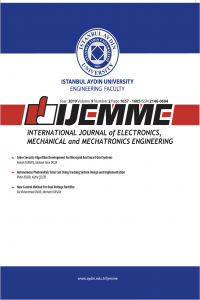BAYESIAN NETWORKS FOR SUB-GROUPS OF MULTIPLE SCLEROSIS
BAYESIAN NETWORKS FOR SUB-GROUPS OF MULTIPLE SCLEROSIS
In this study, patients with multiple sclerosis "sub-groups" characteristics in relation to detection of a statistically (SPSS) and are provided in the Bayesian network. The main objective of this study, regarding the appearance of MRI lesions in patients with Multiple Sclerosis information and / or EDSS scores to investigate the possible attack of multiple sclerosis subgroups. Bayesian networks, reflects the level of sub-groups in multiple sclerosis patients. Analyzes were conducted to determine the change of these properties. MR images of the input data is discussed for the MS patients, the sub-groups of MS, "Remitting Relapsing Multiple Sclerosis", "Secondary Progressive Multiple Sclerosis" with their patients' clinical brain MR images, brain stem, and the Upper Cervical Regions of the corpus callosum-periventricular lesions created in the information. Multiple Sclerosis is owned by the input data is created correctly identify disease subgroups of MS patients for the number of lesions in MR images and MR image of the three regions for the year for which the information used in the EDSS score. Of MS is RRMS, SPMS correctly identify sub-groups of the brain with Brain Stem, and upper cervical regions of the corpus callosum-periventricular lesions in these three points for the region and / or EDSS score information can be emphasized by using the Bayesian networks play an important role in the analysis.
Keywords:
Multiple Sclerosis (MS), Relapsing Remitting Multiple Sclerosis (RRMS) Secondary Progressive Multiple Sclerosis (SPMS), Bayesian Network,
___
- R. Karabudak, N. Işık, A. Siva, Multiple Sklerozda Tanı ve Tedavi Kılavuzu, Bilimsel Tıp Yayınevi, 2009, pp. 5-20.
- B. Kaymakamzade, Progresif başlangıçlı Multiple Skleroz hastalarında aksonal
- belirteçlerinin klinik ve beyin omurilik sıvısı özellikleri temelinde değerlendirilmesi, Yüksel Lisans Tezi, Hacettepe Üniversitesi, 2011.
- J. Gilroy, Basic Neurology, 3 rd Edition, The McGraw-Hill Companies, USA, 2000.
- R. Karabudak, MS ile Yaşamak, Aşina Kitaplar, Ankara, Türkiye, 2006.
- R. Karabudak, A. Siva, A. Altıntaş, D.Y. Kuşcu, Olgularla Multiple Skleroz, Bilimsel Tıp Yayınevi, Ankara, Türkiye, 2011.
- M. Gaspari, G. Roveda, C. Scandellari, S. Stecchi, An expert system for the evaluation of EDSS in multiple sclerosis, Technical Report, Bologna
- http://www.ms-gateway.gen.tr/msi-anlamak/ms
- tanx131sx131/edss-nedir 73.htm.
- Y. Sun, S. Lv, Y. Tang, Construction and application of Bayesian network in early diagnosis of alzheimer disease's system, in: International Conference on Complex Medical Engineering, 2007, pp. 924-929.
- R. Zhang, G. McAllister, B. Scotney, S. McClean, Member, IEEE, G. Houston, Combining Wavelet analysis and Bayesian networks for the classification of auditory brainstem response, IEEE Transactions on Information Technology in Biomedicine 10 (3) (2006) 458-467.
- P. Lan, Q. Ji, C.G. Looney, Information fusion with Bayesian networks for monitoring human fatigue, in: Proceedings of The Fifth International Conference on Information Fusion, 2002, pp. 535- 542.
- A. Meloni, A. Ripoli, V. Positano, Member, IEEE,
- preconditioning improves structure learning of Bayesian networks from medical databases, IEEE Transactions on Information Technology in Biomedicine 13 (6) (2009) 984-989.
- F. Liu, D. Xu, C. Yuan, W. Kerwin, Image segmentation based on Bayesıan network-Markov random field model and its application to in vivo plaque composition, in: 3rd IEEE International Symposium on Biomedical Imaging, 2006, pp. 141- 144.
- R. Palacios, J. Goni, I.M. Forero, J. Iranzo, J. Sepulcre, I. Melero, P. Villoslada, A network analysis of the human T-Cell activation gene network identifies jagged1 as a therapeutic target for autoimmune diseases, PLoS ONE 2 (11) (2007). [13] S. Bozkurt, A. Uyar, K.H. Gülkesen, Comparison of Bayesian network and binary logistic regression methods for prediction of prostate cancer, in: 4thInternational Conference on Biomedical Engineering and Informatics (BMEI), 2011, pp. 1689-1691.
- J.M. De la Fuente, E. Bengoetxea, F. Navarro, J. Bobes, R.D. Alarcon, Interconnection between biological abnormalities in borderline personality disorder: Use of the Bayesian networks model, Psychiatry Research 186 (2-3) (2011) 315-319.
- E. Gultepe, H. Nguyen, T. Albertson, I. Tagkopoulos,
- diagnosis of sepsis patients: a basis for a clinical decision support system, in: IEEE 2nd International Conference on Computational Advances in Bio and medical Sciences, 2012, pp. 1-5.
- J. Pearl, Probabilistic Reasoning in Intelligent Systems: Networks of Plausible Inference, Morgan and Kaufmann, San Francisco, CA, 1988.
- D. Heckerman, A Tutorial on Learning Bayesian Networks, Technical Report, Microsoft Research, 1995.
- N. Friedman, M. Goldszmidt, Learning Bayesian networks with local structure, Cambridge, MA, 1999, pp. 421-459. [19]
- Nonparametric Statistical Methods, Champman & Hall, 2001.
- Y. Karaca, Multiple Skleroz hastalığının ve alt gruplarının
- matematiksel modelin oluşturulması, Doktora Tezi, Marmara Üniversitesi, Fen Bilimleri Enstitüsü, 2012.
- Multiple Sclerosis Trust, Expanded Disability Status
- http://www.mstrust.org.uk/atoz/edss.jsp.
- WinMine Toolkit Tutorial. Available at
- http://research.microsoft.com/en
- us/um/people/dmax/WinMine/Tutorial/Tutorial.htm l.
- E.N. Cinicioğlu, P.P. Shenoy, A new heuristic for learning Bayesian networks from limited datasets: a real – time recommendation system application with RFID system in Grocery Stores, Annals of Operations Research, 2012, 1-21.
- Applied belirlenmesi için optimum bir Scale (EDSS). Available at
- ISSN: 2146-0604
- Başlangıç: 2011
- Yayıncı: İstanbul Aydın Üniversitesi
Sayıdaki Diğer Makaleler
WAVELET ANALYSES OF SOME ATMOSPHERIC PARAMETERS AT BLACK SEA REGION
Zafer ASLAN, Zehra Nevin ÇAĞLAR, D. Nail YENİÇERİ
ON THE FUZZY CONDITIONAL SEQUENCE LOCAL ENTROPY FUNCTION
COMPARISON OF RENEWABLE AND CONVENTIONAL ENERGY COSTS BY WAVELET TECHNIQUES
Aysun SAGBAS, Adnan MAZMANOGLU, Reyhan ALP
USE OF LASER SCANNING FOR CULTURAL HERITAGE DOCUMENTATION
Gulhan BENLI, Derya Gulec OZER
AN ANALYSIS OF THE FISH POPULATIONS BY USING ANN AND WAVELET TECHNIQUES
Guven OZDEMİR, Ahmet TOKGOZLU, Yasemin KAHRAMANER, Zafer ASLAN
BAYESIAN NETWORKS FOR SUB-GROUPS OF MULTIPLE SCLEROSIS
Huseyin YASAR, Murat CEYLAN, Ayse Elif OZTURK
ANALYSIS OF FACTORS IMPACTING LAND USE IN TRANSFORMING ISTANBUL HISTORICAL CITY CENTER
